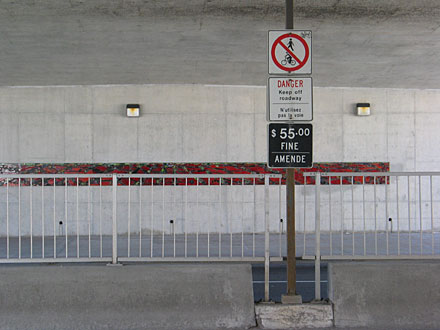
"Ploughed Field: Hillside" by Susan Feindel, Pleasant Park Station, Ceramic and glass mosaic on both sides of the transitway.1995.
Many art commissions paid for with tax dollars are associated with "Percent
for Art" programmes which often use the "integrated design"
approach as an argument for the the inclusion of art expenditures within
a larger plan. By embedding artists and their creative process into
the planning process the artist gets to leverage expertise and funds
for the creation of their work in ways that would be impossible if existing
artworks were simply purchased to place on a site. Doing things this
way creates a signifigant dollar multiplying value theoretically resulting
in harmonious, permanent works which draw upon the skills (and usually
the budgets) of diverse players involved in the site's construction.
Unfortunately this process sometimes robs artworks of their independence
and ability to function because the work is so tightly integrated that
it becomes invisible or is just a replacement for amenities that would
have been provided for anyway. Nonetheless, this approach has become
a very common one which provides a "warranty" to the patrons
that the artwork finally delivered will be well mannered, site appropriate
and not present a challenge to, or subvert the meaning of "place"
as understood by the sponsors. Like many other photographers, I have often made pictures of art for institutions and artists. While doing this I have learned much, made many friends and occasionally a little money. However much fun doing that kind of work is, my satisfaction from it has always been tempered by the creative limits placed on me as someone else's hired "shooter". The client always provides the subject, approves the treatment and judges its success. This
new body or work is made outside of those constraints. The pictures
are of artworks from the National Capital Region. This project has several
dimensions. I am doing this because of a my curiosity and affection for these objects and as a creative mechanism for learning and knowing. With these images I hope I can articulate some ideas and and connections that I see and put questions about living with this kind of art which is a such a defining aspect of seeing my city. As this project grows in size (- currently there are at least 125 images -) many themes and issues become easier to see and illustrate. These pictures show a wide spectrum of stuff including temporary public works, a few graffiti works, some commercial appropriations of well known artists, monuments and works that exist in the exotic territory of the contemporary fine arts milieu. . There are good, bad, neglected , expensive, forgotten , reviled, sentimental and sometimes wonderful things that suggest issues common to much of our public art in our cities. What is it for? Who paid for it? Has it lasted. Should it last? How does it work? What does it mean? And what does it mean to me? The pictures are accompanied by brief texts that tell you the name of the work, the artists, where it is and who owns/commissioned it. Sometimes, there are additional texts which discuss issues that are relevant to thinking about public art in more general terms. Any errors in fact will be corrected promptly if they are brought to my attention. I hope you like them - I will continue adding to this site for quite a long time I expect...... December 2003
|
